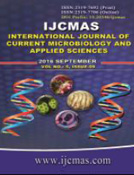


 National Academy of Agricultural Sciences (NAAS)
National Academy of Agricultural Sciences (NAAS)

|
PRINT ISSN : 2319-7692
Online ISSN : 2319-7706 Issues : 12 per year Publisher : Excellent Publishers Email : editorijcmas@gmail.com / submit@ijcmas.com Editor-in-chief: Dr.M.Prakash Index Copernicus ICV 2018: 95.39 NAAS RATING 2020: 5.38 |
Contamination of chicken meat is an important public health problem and food of poultry origin is one of the most common sources of bacterial pathogens. Escherichia coli, Salmonella spp. and Listeria monocytogenes are considered among the most important pathogens which can be spread through meat and meat products consumption. Rapid methods for identification and detection of these dominant foodborne pathogens are still required. This study was conducted to determine the prevalence of these pathogens contamination of imported frozen chicken meat from different origin and locally frozen chicken (leg, breast and giblets) collected over a 6-month period between November and April 2016 from different markets in Baghdad, Iraq. Multiplex polymerase chain reaction (m-PCR) assay for the specific detection of the dominant foodborne bacterial pathogens, including Escherichia coli, Salmonella spp. and Listeria monocytogenes in chicken meat was used. The obtained results indicated that a large percentage of chicken samples 45% was positive for E. coli, followed Salmonella 17%, and L. monocytogenes 11%. The occurrence of E. coli was highest in giblets 26 (52%) followed by leg 22(44%) and breast 19(38%) samples. The occurrence of S.spp. in leg and giblets were 9 (18%), whilst in giblets 8(16%) samples. On other hand the occurrence of L. monocytogenes in giblets was 7 (14%), reduced to 5 (10%) samples in leg and breast. imported frozen chicken meat samples were the most frequently contaminated by E. coli of origin Turkish 63% and Brazilian 53% , followed by Iranian 40%, and while locally frozen chicken samples were the least frequently contaminated 33%. Samples of origin Turkish and Ukrainian the most frequently contaminated by Salmonella 27and 20% respectively, and L. monocytogenes 17%, and whilst locally frozen chicken samples were the least frequently contaminated 13 and 7% respectively. Multiplex PCR was found to be a very sensitive test that allowed rapid and reliable identification of these bacteria.
 |
 |
 |
 |
 |